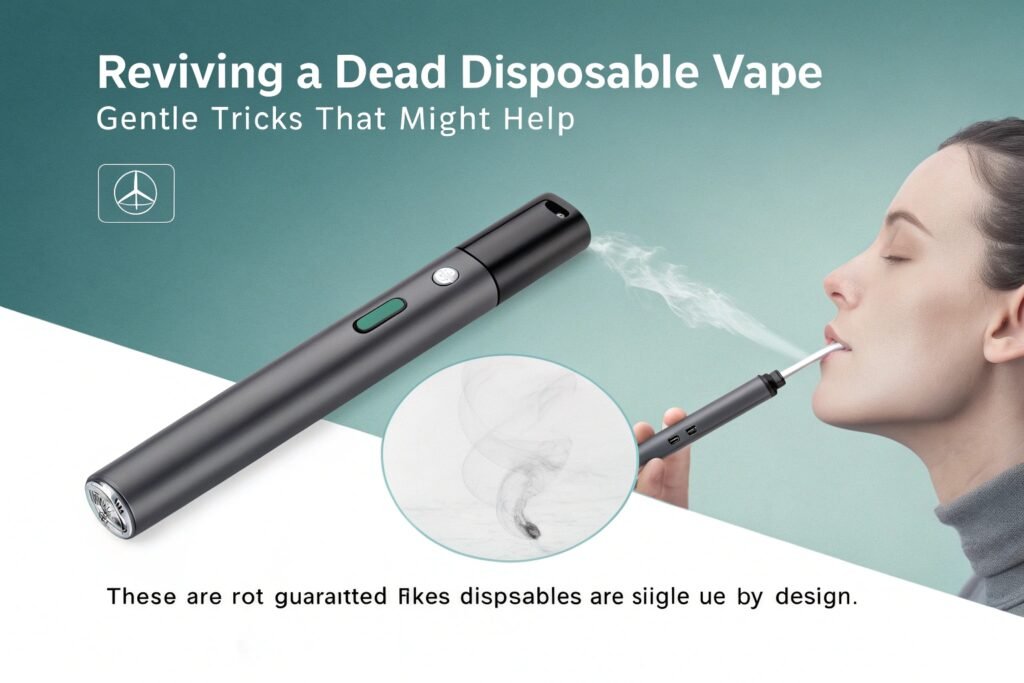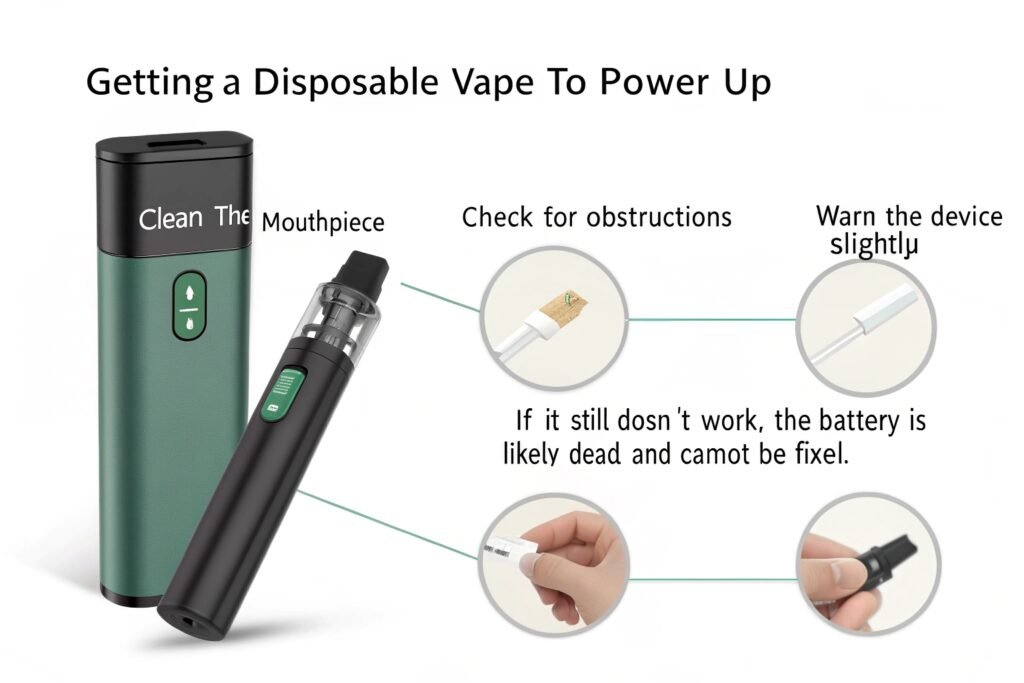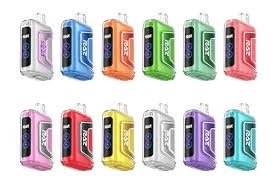Disposable vapes are convenient, but what do you do when they die before you expect? Is there a way to bring them back to life?
While disposable vapes aren't designed to be fixed, there are a few steps you can try to revive them. Check for airflow obstructions, clean the mouthpiece, and ensure the battery isn't completely depleted. However, remember that these fixes are temporary, and disposables are ultimately meant for single use.

"An image illustrating the steps to potentially fix a dead disposable vape, including cleaning and checking for obstructions"
I've seen people try all sorts of things to fix their vapes. Here are some of the more reasonable approaches.
How to make a dead disposable vape hit again?
Sometimes a little coaxing can help.
To try and make a dead disposable vape hit again, first check the airflow. Clear any blockages with a thin object or by gently blowing into the mouthpiece. If that doesn't work, try warming the device slightly (but not too much) to improve e-liquid flow. Keep in mind that these methods are not guaranteed.

"An image showing a person cleaning the mouthpiece of a disposable vape to clear potential airflow obstructions"
A few simple tricks might get it going again.
The common reasons why a disposable vape may stop hitting include a blocked airflow1, a depleted battery2, or a viscous e-liquid3 that is not flowing properly. Drawing from my experience with troubleshooting disposable vapes, I've identified the following key causes. The blocked airflow prevents the sensor from detecting the inhale and activating the device – a blocked airflow prevents the sensor from detecting the inhale and activating the device, resulting in no vapor production. The depleted battery cannot provide power to the coil, rendering the device unusable – a depleted battery cannot provide power to the coil, rendering the device unusable and preventing vapor production. The viscous e-liquid may not flow properly, especially in cold conditions, preventing it from reaching the coil – a viscous e-liquid may not flow properly, especially in cold conditions, preventing it from reaching the coil and hindering vapor production. The e-liquid leakage can flood the coil and prevent it from heating properly – e-liquid leakage can flood the coil and prevent it from heating properly, hindering vapor production and potentially damaging the device. The manufacturing defects can lead to faulty components and prevent the device from functioning correctly – manufacturing defects can lead to faulty components and prevent the device from functioning correctly, resulting in inconsistent or non-existent vapor production.
The potential methods to try to revive a dead disposable vape include clearing the airflow, warming the device, and gently tapping it. Through analyzing user feedback and troubleshooting guides, I've identified the following key solutions. The clearing the airflow by gently blowing into the mouthpiece or using a thin object to remove any obstructions – clearing the airflow ensures that the sensor can detect the inhale and activate the device, potentially restoring vapor production. The warming the device slightly by holding it in your hands or placing it in a warm (not hot) area to improve e-liquid flow – warming the device slightly improves e-liquid flow, allowing it to reach the coil and potentially restore vapor production. The gently tapping the device to dislodge any air bubbles or e-liquid that may be blocking the coil – gently tapping the device dislodges any air bubbles or e-liquid that may be blocking the coil, potentially restoring vapor production. The trying a few short, quick puffs to prime the coil and activate the device – trying a few short, quick puffs primes the coil and activates the device, ensuring that it is ready to produce vapor when inhaled. The avoiding extreme temperatures or humidity, which can damage the battery or e-liquid – avoiding extreme temperatures or humidity prevents damage to the battery or e-liquid, ensuring reliable performance.
The risks and limitations of attempting to revive a dead disposable vape include potential damage to the device, inconsistent results, and the fact that it is not a permanent solution. Through analyzing user experiences and safety guidelines, I've identified the following key considerations. The potential damage to the device can result from attempting to disassemble or modify the device – potential damage to the device can result from attempting to disassemble or modify the device, which can be dangerous and may lead to malfunctions. The inconsistent results mean that the methods may work temporarily or not at all, depending on the cause of the issue – inconsistent results mean that the methods may work temporarily or not at all, depending on the cause of the issue, making it an unreliable solution. The fact that it is not a permanent solution means that the device is ultimately designed for single-use and will eventually need to be replaced – the fact that it is not a permanent solution emphasizes the importance of proper usage and storage to prolong the device's lifespan. The safety concerns can arise from attempting to tamper with the battery or other internal components – safety concerns can arise from attempting to tamper with the battery or other internal components, which can lead to overheating, explosions, or other hazards. The warranty voiding can occur if the user attempts to disassemble or modify the device, rendering it ineligible for replacement or refund – warranty voiding can occur if the user attempts to disassemble or modify the device, leaving them without recourse if the device malfunctions.
How do you fix a disposable vape that won't turn on?
Let's see if we can get it powered up.
If your disposable vape won't turn on, start by cleaning the mouthpiece and checking for any obstructions. Next, try gently warming the device in your hands. If it still doesn't work, the battery is likely dead, and the device cannot be fixed.

"An image of a non-functional disposable vape, with steps illustrated to troubleshoot and potentially fix the issue"
Sometimes it's just a simple fix, but often it's not.
The possible reasons why a disposable vape may not turn on include a dead battery4, a faulty sensor5, or a disconnected internal connection. Drawing from my understanding of disposable vapes and their components, I've identified the following key causes. The dead battery cannot provide power to the coil or sensor, rendering the device unusable – a dead battery cannot provide power to the coil or sensor, rendering the device unusable and preventing it from turning on. The faulty sensor may not detect the airflow, preventing the device from activating even when the user inhales – a faulty sensor may not detect the airflow, preventing the device from activating even when the user inhales. The disconnected internal connection can result from damage or manufacturing defects, preventing the flow of electricity – a disconnected internal connection can result from damage or manufacturing defects, preventing the flow of electricity and causing the device to fail. The e-liquid leakage6 can damage the sensor or battery, preventing the device from functioning properly – e-liquid leakage can damage the sensor or battery, preventing the device from functioning properly and hindering activation. The manufacturing defects can lead to malfunctioning components and prevent the device from turning on – manufacturing defects can lead to malfunctioning components and prevent the device from turning on, resulting in a frustrating and unsatisfactory experience.
The steps to troubleshoot a disposable vape that will not turn on include checking the airflow, warming the device, and trying a different device. Through analyzing troubleshooting guides and user feedback, I've identified the following key solutions. The checking the airflow for any obstructions and clearing them if necessary to ensure proper airflow – checking the airflow for any obstructions and clearing them if necessary ensures proper airflow and allows the sensor to detect the inhale. The warming the device slightly by holding it in your hands to improve battery performance – warming the device slightly improves battery performance, potentially restoring power to the device. The trying a different device to determine if the issue is with the device itself or with the user's technique – trying a different device determines if the issue is with the device itself or with the user's technique, helping to isolate the problem. The ensuring the device is stored properly in a cool, dry place to prevent damage to the components – ensuring the device is stored properly in a cool, dry place prevents damage to the components and ensures reliable performance. The avoiding attempting to disassemble or modify the device, as this can be dangerous and may void the warranty – avoiding attempting to disassemble or modify the device prevents potential harm and ensures the device remains under warranty.
The limitations of attempting to fix a disposable vape that will not turn on include the fact that the battery is not rechargeable and the device is not designed to be disassembled. Through analyzing user experiences and safety guidelines, I've identified the following key constraints. The fact that the battery is not rechargeable means that once the battery is depleted, the device cannot be revived – the fact that the battery is not rechargeable means that once the battery is depleted, the device cannot be revived, making it a limited-use product. The device is not designed to be disassembled, making it difficult to access and repair the internal components – the device is not designed to be disassembled, making it difficult to access and repair the internal components without causing damage. The attempting to disassemble or modify the device can be dangerous and may void the warranty – attempting to disassemble or modify the device can be dangerous and may void the warranty, leaving the user without recourse if the device malfunctions. The relying on the fact that disposable vapes are ultimately designed for single-use and will eventually need to be replaced – relying on the fact that disposable vapes are ultimately designed for single-use emphasizes the importance of proper usage and storage to prolong the device's lifespan. The ultimately, understanding that disposable vapes are not designed to be repaired or maintained, and replacement may be the only option – ultimately, understanding that disposable vapes are not designed to be repaired or maintained, and replacement may be the only option.
What to do if disposable vape battery dies?
When the battery is done, it's usually game over.
If your disposable vape battery dies, the most practical solution is to dispose of the device properly. Disposable vapes are not designed to be recharged, and attempting to do so can be dangerous. Follow local regulations for electronic waste disposal.

"An image of a disposable vape with a depleted battery, highlighting the importance of responsible disposal"
It's important to know when to let go and dispose of it correctly.
The reasons why a disposable vape battery7 cannot be easily replaced or recharged include the device's design, the safety concerns, and the environmental considerations. Drawing from my knowledge of disposable vapes and their limitations, I've identified the following key factors. The device's design is intended for single-use and does not include a charging port or easily accessible battery compartment – the device's design is intended for single-use and does not include a charging port or easily accessible battery compartment, making it difficult to replace or recharge the battery. The safety concerns arise from attempting to tamper with the battery, which can lead to overheating, explosions, or other hazards – the safety concerns arise from attempting to tamper with the battery, which can lead to overheating, explosions, or other hazards. The environmental considerations involve the proper disposal of the device to prevent harm to the environment – the environmental considerations involve the proper disposal of the device to prevent harm to the environment, as disposable vapes contain electronic components and potentially hazardous materials. The the low cost of disposable vapes makes it more practical to replace the device rather than attempt to repair it – the low cost of disposable vapes makes it more practical to replace the device rather than attempt to repair it, as the cost of repair may exceed the cost of a new device. The the complex internal circuitry and small components make it difficult to disassemble and reassemble the device without causing damage – the complex internal circuitry and small components make it difficult to disassemble and reassemble the device without causing damage, requiring specialized tools and knowledge.
The safe and responsible ways to dispose of a dead disposable vape include checking local regulations, finding a designated e-waste recycling center, and avoiding throwing it in the regular trash. Through analyzing environmental guidelines and best practices, I've identified the following key actions. The checking local regulations for the proper disposal of electronic waste8, as regulations may vary by location – checking local regulations ensures compliance with local laws and prevents harm to the environment. The finding a designated e-waste recycling center or collection point in your area to ensure proper handling of the device – finding a designated e-waste recycling center ensures that the device is properly recycled and its components are reused. The avoiding throwing the disposable vape in the regular trash, as this can lead to environmental contamination – avoiding throwing the disposable vape in the regular trash prevents environmental contamination and promotes responsible waste management. The contacting local waste management services for guidance on proper disposal methods – contacting local waste management services provides access to expert advice and ensures that the device is disposed of in an environmentally friendly manner. The promoting responsible consumption by choosing rechargeable or refillable vaping devices when possible – promoting responsible consumption encourages users to choose more sustainable options and reduce waste.
The potential environmental impacts of improperly disposing of disposable vapes9 include soil and water contamination, harm to wildlife, and the release of harmful chemicals. Through analyzing environmental research and reports, I've identified the following key consequences. The soil and water contamination can result from the leaching of heavy metals and other hazardous materials from the device – soil and water contamination can result from the leaching of heavy metals and other hazardous materials from the device, posing a threat to ecosystems and human health. The harm to wildlife can occur if animals ingest or come into contact with the discarded devices – harm to wildlife can occur if animals ingest or come into contact with the discarded devices, leading to injury or death. The release of harmful chemicals into the environment can result from the improper incineration of the devices – the release of harmful chemicals into the environment can result from the improper incineration of the devices, contributing to air pollution and potential health risks. The the accumulation of plastic waste in landfills and natural environments can contribute to plastic pollution and ecosystem degradation – the accumulation of plastic waste in landfills and natural environments can contribute to plastic pollution and ecosystem degradation, harming marine life and terrestrial ecosystems. The the energy consumption and resource depletion associated with the manufacturing of disposable vapes contribute to environmental degradation – the energy consumption and resource depletion associated with the manufacturing of disposable vapes contribute to environmental degradation, emphasizing the importance of reducing consumption and promoting sustainable alternatives.
Can disposable vapes be fixed?
Let's set some realistic expectations.
Generally, disposable vapes cannot be reliably fixed. They are designed for single-use and are not intended to be disassembled or repaired. While some temporary fixes may work, they are not a long-term solution.

"An image of a disassembled disposable vape, emphasizing the complexity and challenges of attempting to repair it"
The truth is, they're made to be replaced, not repaired.
The design and construction of disposable vapes that make them difficult to repair include the sealed components10, the small size, and the lack of replaceable parts. Drawing from my knowledge of disposable vapes and their construction, I've identified the following key factors. The sealed components prevent easy access to the internal parts, making it difficult to diagnose and repair any issues – the sealed components prevent easy access to the internal parts, making it difficult to diagnose and repair any issues without causing damage. The small size of the components makes it challenging to handle and repair them without specialized tools and expertise – the small size of the components makes it challenging to handle and repair them without specialized tools and expertise. The lack of replaceable parts means that if a component fails, the entire device must be replaced – the lack of replaceable parts means that if a component fails, the entire device must be replaced, as individual parts are not available for purchase. The the low cost of disposable vapes makes it more practical to replace the device rather than attempt to repair it – the low cost of disposable vapes makes it more practical to replace the device rather than attempt to repair it, as the cost of repair may exceed the cost of a new device. The the complex internal circuitry and intricate connections make it difficult to troubleshoot and repair the device without causing further damage – the complex internal circuitry and intricate connections make it difficult to troubleshoot and repair the device without causing further damage, requiring specialized knowledge and experience.
The reasons why attempting to fix a disposable vape may be dangerous or ineffective include the risk of battery explosion11, the potential for electrical shock, and the limited success rate. Through analyzing user experiences and safety guidelines, I've identified the following key concerns. The risk of battery explosion can result from attempting to tamper with the battery or charging it improperly – the risk of battery explosion can result from attempting to tamper with the battery or charging it improperly, leading to serious injury or property damage. The potential for electrical shock can occur if the device is disassembled or modified improperly – the potential for electrical shock can occur if the device is disassembled or modified improperly, posing a threat to the user's safety. The limited success rate means that the methods may work temporarily or not at all, depending on the cause of the issue – the limited success rate means that the methods may work temporarily or not at all, depending on the cause of the issue, making it an unreliable solution. The the potential for exposure to harmful chemicals can result from disassembling the device and handling the e-liquid – the potential for exposure to harmful chemicals can result from disassembling the device and handling the e-liquid, posing a health risk to the user. The the warranty voiding can occur if the user attempts to disassemble or modify the device, rendering it ineligible for replacement or refund – the warranty voiding can occur if the user attempts to disassemble or modify the device, leaving them without recourse if the device malfunctions.
The alternatives to fixing a disposable vape include purchasing a new disposable vape, switching to a rechargeable vape12, or using a refillable pod system. Through analyzing user preferences and vaping options, I've identified the following key alternatives. The purchasing a new disposable vape is the simplest and most reliable solution, ensuring a functioning device – purchasing a new disposable vape is the simplest and most reliable solution, ensuring a functioning device and a satisfying vaping experience. The switching to a rechargeable vape offers a more sustainable and cost-effective option in the long run – switching to a rechargeable vape offers a more sustainable and cost-effective option in the long run, reducing waste and saving money on disposable devices. The using a refillable pod system allows for more control over the e-liquid and device settings, providing a customizable vaping experience – using a refillable pod system allows for more control over the e-liquid and device settings, providing a customizable vaping experience and potentially reducing costs. The exploring different brands and devices to find one that meets your needs and preferences – exploring different brands and devices helps users find a reliable and satisfying vaping experience. The prioritizing responsible consumption and proper disposal methods to minimize environmental impact – prioritizing responsible consumption and proper disposal methods minimizes environmental impact and promotes sustainability.
Conclusion
While tempting to fix a dead disposable vape, it's usually not feasible or safe. Focus on proper disposal and consider more sustainable vaping options.
-
Understanding the causes of blocked airflow can help you troubleshoot and fix your disposable vape effectively. ↩
-
Learn how to address battery issues in disposable vapes to ensure they function properly and last longer. ↩
-
Explore how viscous e-liquids can impact your vaping experience and find solutions to improve flow. ↩
-
Explore this link to understand how a dead battery affects disposable vapes and potential solutions. ↩
-
This resource will provide insights into how a faulty sensor can prevent your vape from working properly. ↩
-
Learn about the impact of e-liquid leakage on vape performance and how to prevent it from happening. ↩
-
Understanding the limitations of disposable vape batteries can help you make informed choices about vaping products and their environmental impact. ↩
-
Learning about proper disposal methods can help you protect the environment and comply with local regulations regarding electronic waste. ↩
-
Exploring the environmental consequences can raise awareness and encourage responsible disposal practices to protect our planet. ↩
-
Understanding the challenges of sealed components can help you make informed decisions about vape repairs and replacements. ↩
-
Exploring the risks associated with battery explosions can enhance your safety and awareness when using disposable vapes. ↩
-
Discovering the advantages of rechargeable vapes can lead to more sustainable and cost-effective vaping choices. ↩





